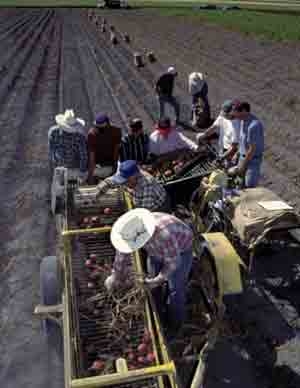
Posts Tagged: Philip Martin
California has a stable farm workforce

Led by Philip Martin, professor emeritus in the Department of Agricultural and Resource Economics at UC Davis, scientists analyzed all Social Security numbers reported by farm employers in 2014. The total number of farmworkers employed in California in 2014 was 829,300. The number of full-time equivalent jobs was 410,900.
“We have lots of people who do farm work in California,” Martin said. “If we could use more of them year round, we would not have to always be looking for immigrants.”
Interest in farmworkers and farm employment is growing in California and in the nation. Comments about illegal immigration by presidential candidates and a new law under consideration in California to require overtime pay for farmworkers have made farm employment part of a national conversation. California's labor-intensive fruit and vegetable production systems, the tightening of border controls and proposals to give some unauthorized workers a temporary legal status have also fueled interest.
“Many farm employers argue that there are farm labor shortages, while worker advocates counter that there is only a shortage of wages to attract and retain farmworkers,” Martin said. “Our objective was to provide a clearer picture of California's agricultural workforce by determining the actual number of wage and salary workers in agriculture.”
The research was based on information from the state's Employment Development Department, which collects data on farmworkers and wages paid when it collects unemployment insurance taxes from employers.
The results of the 2014 analysis are compared with previous analyses of farm employment going back to 1990. The data reflect a shift over the last 30 years away from direct-hire employment on crop farms and toward employment by farm labor contractors.
“Crop support services, like farm labor contractors, surpassed on-farm hires for the first time in 2007,” Martin said. “Since 2010, average employment reported by crop support establishments has been rising by 10,000 a year.”
In 2014, nonfarm crop support firms brought an average of 205,000 farmworkers to crop farms, while direct-hires on crop farms was 175,000.
“Our data show that California has a remarkably stable workforce,” Martin said. “We found that most farmworkers are attached to one farm employer, often a labor contractor who moves them from farm to farm.”
Average earnings for all workers who held at least one farm job during the year was over $19,000 in 2014, while average earnings of those who had their maximum earnings in agriculture was $16,500. Farmworkers who were employed by farm labor contractors had the lowest average earnings at $12,719.
In addition to Martin, the article was authored by Muhammad Akhtar, Brandon Hooker and Marc Stockton of the California Employment Development Department. California Agriculture journal is the peer-reviewed research journal of UC Agriculture and Natural Resources.
Wide-ranging impacts of the California drought expected this summer

The article said west side farming giant Harris Ranch plans to fallow thousands of acres of cropland and use it's scarce water supplies to irrigate permanent crops: almonds, pistachios and asparagus. The ranch says it will hire at least 1,000 fewer field workers than usual this year.
“The trees are there. They can't be moved, they can't be put away,” said David Goldhamer, UC Cooperative Extension specialist emeritus in the Department of Land, Air and Water Resources at UC Davis.“They can't be put on hold for a year.”
Most growers will be able to squeeze out a crop, although some will have to settle for sprinkling just enough water on the trees to keep them alive. Goldhamer said yields will fall by as much as 25 percent, mainly because the almonds themselves won't grow to full size.
“You'll have a crop, (but) the nuts will be small,” Goldhamer said.
The Bee article also outlined the drought's projected impact on the state ag economy. The water coalition said farm production could fall by more than $3.5 billion, nearly a tenth of the usual $44 billion in annual production. Factoring in related businesses, the state's economy could lose $7.5 billion, the coalition said.
Richard Howitt, professor in the Department of Agricultural and Resource Economics at UC Davis, said at least 20,000 farmworkers will lose their jobs, putting enormous strain on areas of California where unemployment is typically in double-digit percentages even during good times.
A post in the Rural California Report blog of the California Institute for Rural Studies painted a more detailed portrait of the California ag economy during the drought.
Philip Martin, professor in the Department of Agricultural and Resource Economic at UC Davis, says that with a $1 million reduction in farm revenue, 20 to 50 jobs are lost. However, with less water, farmers shift their water use from low value crops like cotton to high value crops like melons. These high value crops located, for the most part, east of Highway 99 in the San Joaquin Valley, are also more labor intensive. This shift in water use could limit the effects of water losses on farm employment numbers. Martin estimates that there will be a reduction of irrigated acres in the San Joaquin Valley from 5 million to between 3.5 and 4 million acres.
Dan Sumner, director of the UC Agricultural Issues Center, summed up the impact of the current drought as follows:
“This is a real idling of land, and there is nothing positive about it. It's not fallowing — that implies a choice. This is not like North Dakota, where we know it's going to get better. We're talking either spending huge sums on bringing water in or thousands of acres lost.”
California farmers fear labor shortage, but experts are skeptical

"(Border crossing) is more dangerous because of the drug cartels, our government is doing a better job of enforcing the borders and the Mexican economy is doing better," said Jim Lincoln, a vintner and former president of the Napa County Farm Bureau.
Phil Martin, professor in the Department of Agricultural and Resource Economics at UC Davis, paints a different picture. He estimates the yearly number of farm laborers has remained steady in the last decade at around 800,000 people after it had expanded in the 1990s.
Martin is skeptical of perennial farmworker shortage warnings, finding no signs of diminished crops or fewer workers in a 2007 report, but five years later he says the farming community has hit "a period of uncertainty."
New law aims to reduce farmworker intimidation
An article by Gosia Wozniacka for the Associated Press discusses a new law signed Sunday by Gov. Jerry Brown that aims to make farmworker unionization easier, by automatically certifying union elections if a grower intimidates workers during the election process. The reporter turned to Philip Martin, professor with the UC Davis Department of Agricultural and Resource Economics, for analysis of the law and what differences it could make. Martin told the reporter that it was hard to tell, but that making unionization easier could also put pressure on farmworker wages. "This is a very evolutionary change, not revolutionary," he said.

istock election photos
Immigration reform and enforcement could be costly for farmers

The story was based on research by agricultural economists at UC Davis and the U.S. Department of Agriculture. The report, titled “Labor Trajectories in California’s Produce Industry,” found that changes in the way immigrant labor is regulated in the U.S. would increase the cost of labor for California's $20 billion fresh fruit, nut and vegetable industry.
“California’s produce industry depends on a constant influx of new, foreign-born laborers, and more than half of those are unauthorized laborers, primarily from Mexico,” the UC Davis news release quotes Phillip Martin, a professor of agricultural and resource economics.
“The cost of hiring these laborers will likely rise as the U.S. government ramps up enforcement of immigration laws by installing more physical barriers along the U.S.-Mexico border and requiring more audits of workers’ I-9 employment verification forms,” Martin said.
Read more in the current issue of the ARE Update.
